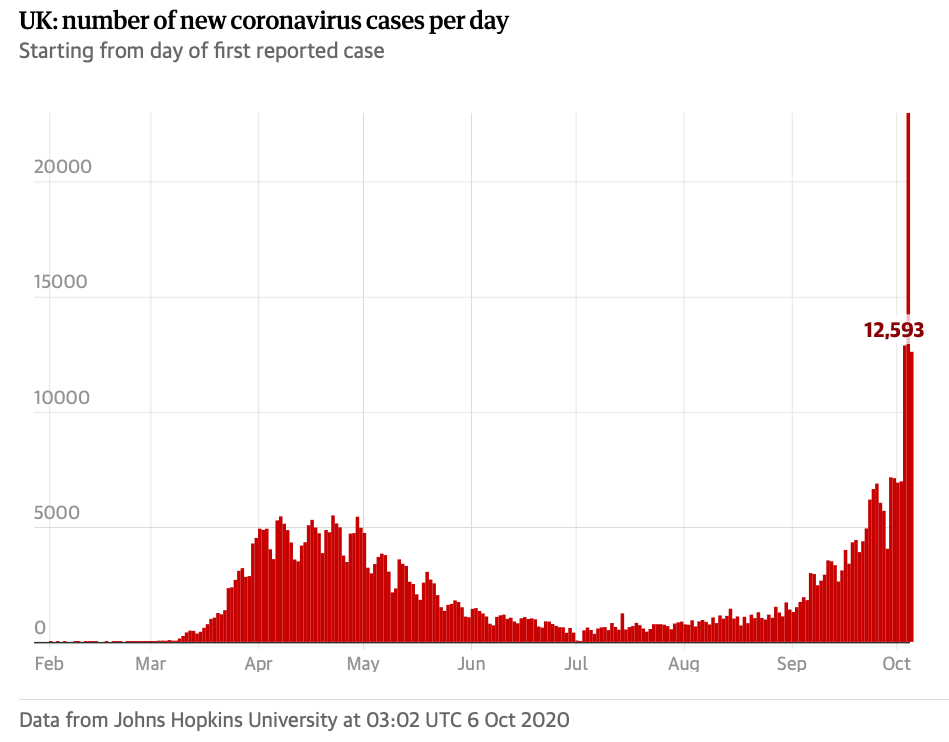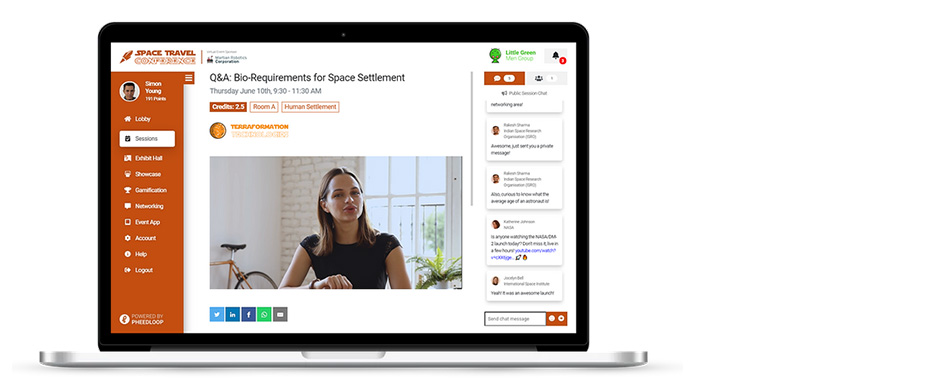Eduvation Blog
Wednesday, October 7, 2020 | Category: Eduvation Insider
Recreating Events in a Virtual World

Good morning!
Yesterday, we looked at how to improve the Zoom experience and counteract Zoom fatigue, so that meetings and classes can continue during a pandemic. But so-called “videoconferences” don’t actually handle conferences that well, with their concurrent streams of sessions, exhibit halls, and registered attendees who can flow in and out of meeting “rooms.”
Now that conferences, conventions, receptions, fairs and events of all kinds have been forcible thrust out of “meatspace” and into cyberspace, there are naturally plenty of software developers rushing in to augment what Zoom et al. can offer.
Today, we’ll take a look at some of the event platforms being used in higher ed today – and get a sneak peek at Ontario Colleges’ plan for a VR version of their annual Toronto fair next month.
But as usual, first some pandemic updates…
Canada’s Second Wave
Lest you fall for any of the rhetoric coming from politicians who want to keep the economy (and schools) open, there is little doubt that Canada is entering a second wave that looks like it will be vastly bigger than the first:

Graph of new COVID19 cases, 7-day average, as of Oct 6 – from CTV
7 Reasons It’ll Get Worse
Ontario, Quebec, and Manitoba have seen an upswing in the past month, and even PEI and Nunavut are logging new cases. CTV argues the graph above is “just the tip of the iceberg,” because 1) hospitalizations will follow after a week or so lag time, 2) the cases are themselves lagging infection by up to 2 weeks, so new restrictions won’t stop the upward curve for some time, 3) the healthcare sector is “incredibly precarious at the best of times,” 4) testing and contact-tracing capacity has been overwhelmed, resulting in significant delays in Alberta, Manitoba and Ontario, 5) COVID is spreading into remote areas like northern Manitoba and Nunavut, 6) Canada is allowing >200,000 travellers across its borders every week, and not all are obeying quarantine rules, and 7) of course, winter is coming. CTV
“Ontario has lost control of COVID. I say that because we’re no longer able to do contact tracing. We’re no longer able to do testing in a reasonable period of time.” – Colin Furness, Epidemiologist, University of Toronto
Pandemic at the Gates
Around the northern hemisphere, higher ed campuses are trying to navigate the fall return to class while coping with outbreaks in and around them…

UK Blended Strategy “Unravels”
In the UK, daily new COVID19 cases have skyrocketed to 4x the springtime peak, and >5,000 students and staff have tested positive at 80 universities. Now, 3 of the nation’s largest institutions – uManchester, uSheffield, and Manchester Metropolitan U – are suspending F2F teaching until at least the end of October. MMU ordered 1,700 students into isolation in late September. The University and College Union called for all classes to move online 10 days earlier, and blames the administrations for the subsequent outbreaks. At Northumbria U, a strike vote has been called and staff are demanding the president resign. The Guardian
While uArizona is Resuming F2F
Shelter-in-place quarantine orders have been in place at uArizona since mid-September, the school has had2,378 confirmed cases of COVID19 on campus since it reopened, and 126 COVID-positive students are still in isolation – but yesterday the school announced it would be reintroducing small F2F classes starting next week. The president insists uArizona has had “no instances of transmission in a classroom or laboratory.” University Business
1,300 Violations at Penn State
The Office of Student Conduct Violations at Penn State U has responded to 1,300 violations of COVID health and safety policies, and issued 1,277 sanctions. 1,046 of those sanctions were warnings, 204 were placed on probation, and 10 students were suspended for the remainder of the year. 17 students have been evicted from on-campus housing. Penn State
Florida State U president John Thrasher and his wife have tested positive for COVID19 and are in isolation. As of Saturday, FSU had seen 1,500 students and 32 employees test positive this fall. US News
COVID en Québec
Here in Canada, the only pandemic curve to rival the UK and US is to be found in La Belle Province…
Quebec Breaks More Records
For the second straight day, Quebec has set records (and not in a good way) for new COVID19 infections: 1,364 on Tuesday, the highest ever. Quebec has now confirmed >81,000 cases and 5,899 deaths – more than half of the whole country. The government claims it doesn’t know where community transmission is occurring, so it is closing restaurant dining rooms, bars, theatres and more for the month of October. Inauspiciously, 666 schools in Quebec have active COVID cases among staff or students. Globe & Mail
Quebec Clamps Down in Red Zones
Universities and CEGEPs in Quebec’s “red zones” are expected to apply the emergency protocols already developed for the most extreme situation, delivering as much as possible remotely. Student unions complain that the protocols have not been well-publicized, and don’t specify which courses will still have in-person “essential” components. Journal de Montréal
McGill U has 5 new confirmed COVID19 cases among students living in downtown residences. CTV
Red Zone CEGEP plans F2F Exams
Hundreds of students at CEGEP Garneau are concerned about mid-October exams, which could bring up to 150 people together in the same room, despite the fact that Quebec City has moved into the red zone. The provincial police have deployed roadblocks to limit movement in or out of red zones, but students taking online courses might still have to return to write in-person exams. The CEGEP says masks will be mandatory, exam papers will be isolated for 48 hours, and disinfection specialists will clean the gym between exams. Journal de Montréal
Canadian Winter
3 more CdnPSEs have now announced largely online delivery into 2021…
Mount St Vincent U’s senate has agreed to continue with primarily online course delivery for the winter 2021 semester “and explore with faculty the opportunity for multi-access delivery of a limited number of courses – meaning some winter semester courses may be delivered simultaneously online and on-campus.” MSVU
U New Brunswick has announced that they will continue to offer a blended learning model for the winter term. The calendar has been adjusted to permit self-isolation after the December break. UNB
Royal Military College (Kingston ON) is sending its 300 first-year students home for the rest of the semester, after (Canadian) Thanksgiving this weekend. Basic training is now complete, and they will continue to study online from home – along with the other 800 upper-year students. CTV
So what’s past is prologue – just in case you’re still not convinced that we’ll be planning virtual events throughout 2021 (and likely into 2022). So now, the fun stuff: what could those events look like?
Virtual Conferences
We can recreate the keynotes, papers, and poster sessions readily enough, and even browse electronic vendor exhibits or line up to chat with a salesperson, but the unplanned, unscheduled conversations that are often most valuable, are missing. At least, so far I haven’t yet experienced a conference platform that adequately replicates the experience of walking into a reception wine and cheese, or meeting new people in the lunch buffet lineup…
Events Platforms
As conferences have, by necessity, migrated online, hundreds of platforms have arisen to augment the videoconferencing tools in Zoom to permit more self-directed exploration in what feels like a unified event space. Most track registered delegates and allow text-based chat between those in attendance. Some permit video sidebar discussion. All allow users to move between parallel conference tracks and simultaneous sessions, or to access recordings afterwards. Zoom breakout rooms are invaluable to create a more collaborative, interactive approach to meetings, workshops or classes – but they still have real limitations.
How to Make the Pivot
The US Chamber of Commerce has inventoried hundreds of virtual event platforms, from Aventri to Zuant, and recommends its top 10: 6Connect, Airmeet, Boomset, EventCreate, EventGroove, EngageZ, Hubb, Juven, RegFox, and Socio. They also offer tips for an effective virtual event. US Chamber

Online Career Fairs
Brazen is a third-generation platform to host college or university career fairs with exhibitor booths, student profiles/résumés, live presentations and peer networking – although they also have adapted it for PSE admission events, orientation and alumni networking events. Brazen
Academic Conferences
Whova is a mobile-first hybrid event management platform that helps you readily manage sponsors, exhibitors, registrants, bios, business cards, live polls, networking, and simultaneous sessions (when integrated with livestream and video platforms). Their clients include Stanford, Harvard, MIT, UC Berkeley, Wharton, Yale, and uChicago. Whova

A Canadian Solution
Pheedloop, based in Toronto, is also hybrid event management software that allows you to embed parallel Zoom or Bluejeans sessions, manage exhibitors, speakers and attendees. Their clients include uToronto, and I’ve participated in several events myself that use Pheedloop. It still feels a bit clunky to me, but it adds some functionality that Zoom really ought to integrate itself. Pheedloop
Ontario College Virtual Fair
I just noticed last night on Twitter that Ontario Colleges are taking their annual Toronto Information Fair virtual this year, as a “fully interactive” experience. (If you’ve never been, one of my very first webcasts was at the 2013 OCIF.) Prospective students will “soon” be able to register for the OCVF, create their own avatar, and then navigate the virtual event Nov 4-5, join info sessions, and speak with faculty and staff from Ontario’s 24 colleges. The interface reminds me a lot of Second Life – your best glimpse of what’s in store is this 1:20 min video on YouTube.
#ICYMI
A World of Innovation
When you want to depict a normal world during a pandemic – or futuristic innovations thereafter – animation offers some natural advantages, which Ryerson U leverages to create a series of distinctive animated shorts in the “World of Innovation” series, released yesterday. The longest is just 1:10 min, and depicts “a future in which we’ll harness the sun, the rain, and the earth to create sustainable design,” and create “an economy that’s good for the environment.” 6 clever, program-specific, 15-sec vids in the series focus on Urban Design, Social Justice, Creativity and Culture, Economic Development, Migration & Integration, and Urban Health & Wellbeing. YouTube
Thanks for reading! Tomorrow, we’ll look at new software institutions are using to try to recreate the sense of campus community – without the campus!
Meanwhile, stay safe and be well,

All contents copyright © 2014 Eduvation Inc. All rights reserved.